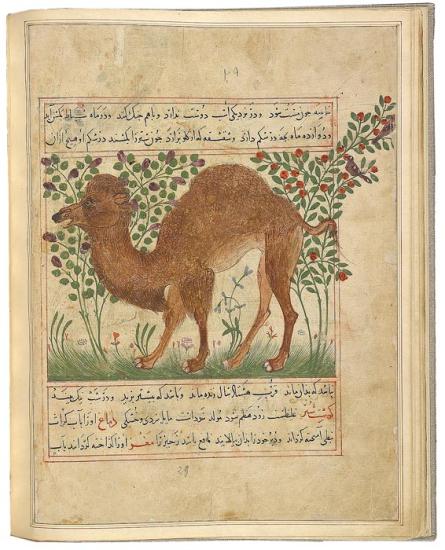
Camel
Manāfi˓-i ḥayavān (The Benefits of Animals), in Persian, for Shams al-Dīn Ibn Ẓiyā˒ al-Dīn al-Zūshkī
Purchased by Pierpont Morgan, 1912
This illustration appears in the great Persian manuscript Manāfi˓-i ḥayavān (The Benefits of Animals). The camel's forelegs are too short, suggesting that the artist's model was too large to fit the available space, and its head has a strange pompadour of hair, perhaps to compensate for the short legs. According to the text the camel is revengeful and thus has a good memory. They conceive in February, have a twelve-month gestation period, and hate the company of horses, as they always fight. Different parts of the camel were used medicinally. Its hump, for example, is good for dysentary; melted and mixed with chive juice it relieves the pain caused by piles.
Natural History and Astrology
The miniatures presented here derive primarily from two extraordinary Islamic manuscripts that depict the natural world and the heavens. The first, Manāfi˓-i hayavān (The Benefits of Animals), is considered one of the ten greatest surviving Persian manuscripts. It dates from the reign of Ghazan Khan (1295–1304), the Mongol ruler who ordered a Persian translation of the book, and concerns the nature and medicinal properties of humans, animals, birds, reptiles, fish, and insects. The other, Matāli˓ al-sa˓āda wa manābi˓ al-siyāda (The Ascension of Propitious Stars and Sources of Sovereign), was commissioned by Sultan Murād III (r. 1574–95), an Ottoman ruler deeply interested in astronomy, cosmology, demonology, poetry, and mysticism.
